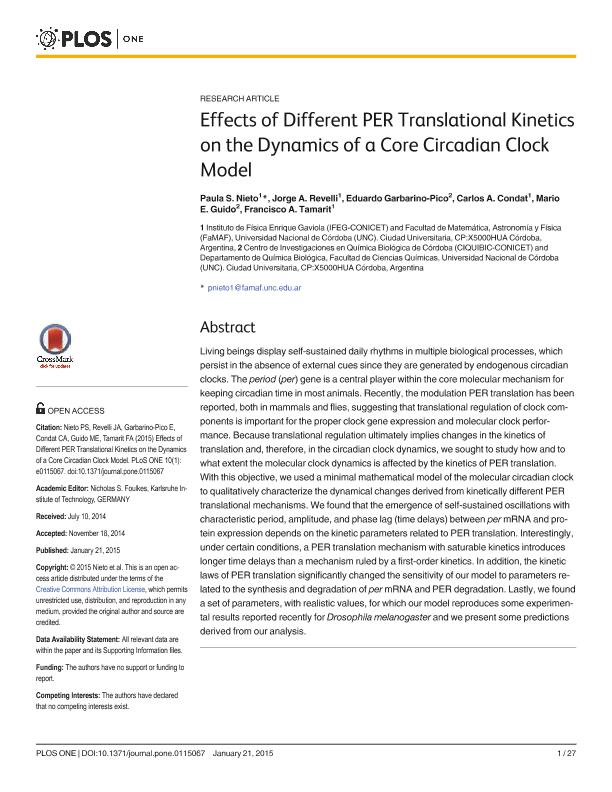Mostrar el registro sencillo del ítem
dc.contributor.author
Nieto, Paula Sofia

dc.contributor.author
Revelli, Jorge Alberto

dc.contributor.author
Garbarino Pico, Eduardo

dc.contributor.author
Condat, Carlos

dc.contributor.author
Guido, Mario Eduardo

dc.contributor.author
Tamarit, Francisco

dc.date.available
2016-12-29T18:52:54Z
dc.date.issued
2015-01-21
dc.identifier.citation
Nieto, Paula Sofia; Revelli, Jorge Alberto; Garbarino Pico, Eduardo; Condat, Carlos; Guido, Mario Eduardo; et al.; Effects of different PER translational kinetics on the dynamics of a Core Circadian Clock model; Public Library Of Science; Plos One; 10; 1; 21-1-2015; 1-27
dc.identifier.issn
1932-6203
dc.identifier.uri
http://hdl.handle.net/11336/10632
dc.description.abstract
Living beings display self-sustained daily rhythms in multiple biological processes, which persist in the absence of external cues since they are generated by endogenous circadian clocks. The period (per) gene is a central player within the core molecular mechanism for keeping circadian time in most animals. Recently, the modulation PER translation has been reported, both in mammals and flies, suggesting that translational regulation of clock components is important for the proper clock gene expression and molecular clock performance. Because translational regulation ultimately implies changes in the kinetics of translation and, therefore, in the circadian clock dynamics, we sought to study how and to what extent the molecular clock dynamics is affected by the kinetics of PER translation. With this objective, we used a minimal mathematical model of the molecular circadian clock to qualitatively characterize the dynamical changes derived from kinetically different PER translational mechanisms. We found that the emergence of self-sustained oscillations with characteristic period, amplitude, and phase lag (time delays) between per mRNA and protein expression depends on the kinetic parameters related to PER translation. Interestingly, under certain conditions, a PER translation mechanism with saturable kinetics introduces longer time delays than a mechanism ruled by a first-order kinetics. In addition, the kinetic laws of PER translation significantly changed the sensitivity of our model to parameters related to the synthesis and degradation of per mRNA and PER degradation. Lastly, we found a set of parameters, with realistic values, for which our model reproduces some experimental results reported recently for Drosophila melanogaster and we present some predictions derived from our analysis.
dc.format
application/pdf
dc.language.iso
eng
dc.publisher
Public Library Of Science

dc.rights
info:eu-repo/semantics/openAccess
dc.rights.uri
https://creativecommons.org/licenses/by-nc-sa/2.5/ar/
dc.subject
Circadian Clocks
dc.subject
Per Translation
dc.subject
Mathematical Models
dc.subject
Post-Transcriptional Modulation
dc.subject.classification
Biología

dc.subject.classification
Ciencias Biológicas

dc.subject.classification
CIENCIAS NATURALES Y EXACTAS

dc.title
Effects of different PER translational kinetics on the dynamics of a Core Circadian Clock model
dc.type
info:eu-repo/semantics/article
dc.type
info:ar-repo/semantics/artículo
dc.type
info:eu-repo/semantics/publishedVersion
dc.date.updated
2016-12-28T17:54:57Z
dc.journal.volume
10
dc.journal.number
1
dc.journal.pagination
1-27
dc.journal.pais
Estados Unidos

dc.journal.ciudad
San Francisco
dc.description.fil
Fil: Nieto, Paula Sofia. Consejo Nacional de Investigaciones Científicas y Técnicas. Centro Científico Tecnológico Córdoba. Instituto de Física "enrique Gaviola"; Argentina. Universidad Nacional de Córdoba. Facultad de Matemática, Astronomía y Física; Argentina
dc.description.fil
Fil: Revelli, Jorge Alberto. Consejo Nacional de Investigaciones Científicas y Técnicas. Centro Científico Tecnológico Córdoba. Instituto de Física "enrique Gaviola"; Argentina. Universidad Nacional de Córdoba. Facultad de Matemática, Astronomía y Física; Argentina
dc.description.fil
Fil: Garbarino Pico, Eduardo. Consejo Nacional de Investigaciones Científicas y Técnicas. Centro Científico Tecnológico Córdoba. Centro de Investigaciones En Química Biológica de Córdoba (p); Argentina. Universidad Nacional de Córdoba. Facultad de Ciencias Químicas. Departamento de Quimica Biológica; Argentina
dc.description.fil
Fil: Condat, Carlos. Consejo Nacional de Investigaciones Científicas y Técnicas. Centro Científico Tecnológico Córdoba. Instituto de Física "enrique Gaviola"; Argentina. Universidad Nacional de Córdoba. Facultad de Matemática, Astronomía y Física; Argentina
dc.description.fil
Fil: Guido, Mario Eduardo. Consejo Nacional de Investigaciones Científicas y Técnicas. Centro Científico Tecnológico Córdoba. Centro de Investigaciones En Química Biológica de Córdoba (p); Argentina. Universidad Nacional de Córdoba. Facultad de Ciencias Químicas. Departamento de Quimica Biológica; Argentina
dc.description.fil
Fil: Tamarit, Francisco. Consejo Nacional de Investigaciones Científicas y Técnicas. Centro Científico Tecnológico Córdoba. Instituto de Física "enrique Gaviola"; Argentina. Universidad Nacional de Córdoba. Facultad de Matemática, Astronomía y Física; Argentina
dc.journal.title
Plos One

dc.relation.alternativeid
info:eu-repo/semantics/altIdentifier/doi/http://dx.doi.org/10.1371/journal.pone.0115067
dc.relation.alternativeid
info:eu-repo/semantics/altIdentifier/url/https://www.ncbi.nlm.nih.gov/pmc/articles/pmid/25607544/
dc.relation.alternativeid
info:eu-repo/semantics/altIdentifier/url/http://journals.plos.org/plosone/article?id=10.1371/journal.pone.0115067
Archivos asociados
